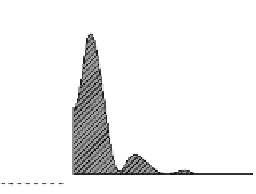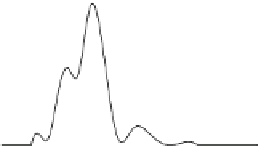Biomedical Engineering Reference
In-Depth Information
(a)
(c)
1.0
1.0
4x10
16
4x10
16
η
ice
η
water
0.8
0.8
3x10
16
η
ice
η
water
3x10
16
0.6
0.6
2x10
16
2x10
16
0.4
0.4
1x10
16
1x10
16
0.2
0.2
0
0
0.0
0.0
0.0
0.0
5.0x10
-15
1.0x10
-14
1.5x10
-14
5.0x10
-15
1.0x10
-14
1.5x10
-14
(b)
(d)
Cell volume, V [m
3
]
Cell volume, V [m
3
]
1.0
1.0
PIIF
PIIF
detect
PIIF
init
0.8
0.8
0.6
0.6
0.4
0.4
PIIF
PIIF
detect
PIIF
init
0.2
0.2
0.0
0.0
0
-10
-20
-30
-40
0
-10
-20
-30
-40
Temperature, T [°C]
Temperature, T [°C]
Fig. 11 Simulation results for the cooling stage carried out at -50C/min in absence of CPA
under the assumption of extra-cellular thermodynamic equilibrium in left column (a-b) and
dynamics for EIF in right column (c-d) (adapted from [
11
])
case of -50C/min when considering thermodynamic equilibrium conditions and
the dynamics of EIF are compared to better highlight the differences. Specifically,
the plots in the left column of Fig.
11
(i.e. panels (a-b)) show the results obtained
when considering thermodynamic equilibrium conditions, whilst in the right col-
umn the results obtained for dynamic EIF are reported (i.e. panels (c-d)). The
initial cell size distribution, the internal ice volume fraction g
ice
, and the total water
fraction g
water
at -40C as a functions of the initial cell volume are compared in
top plots 11a and c, whilst in bottom plots 11b and d the profiles of PIIF, PIIF
init
,
and PIIF
detect
vs. temperature are shown.
As can be seen, considering thermodynamic equilibrium conditions or dynamic
EIF for the suspending solution does have an effect and different model results are
obtained using either one or the other approach. In fact, whilst differently sized
cells in a single population exhibit different IIF temperatures under the same
operating conditions in both cases, when using a dynamic EIF a smaller ice per-
centage is generally obtained at -40C in comparison to the case of equilibrium
conditions (i.e. Fig.
11
c-d vs Fig.
11
a-b). This is because, at this cooling rate
osmosis may actually take place for a relatively short period of time and the
dynamic EIF is slow enough to limit further the time window available for the
water efflux out of the cells, thus facilitating IIF.





















































































































































































































Search WWH ::

Custom Search